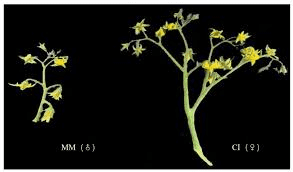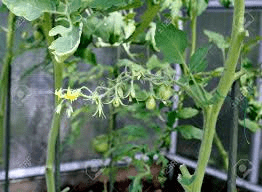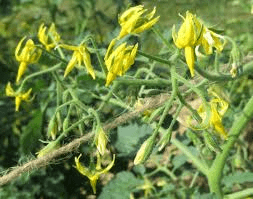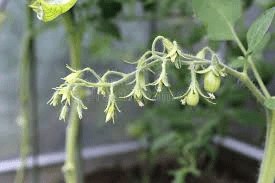The tomato inflorescence refers to the arrangement of flowers on the tomato plant, crucial for its reproductive cycle and subsequent fruit development. Botanically, tomatoes belong to the Solanaceae family and produce inflorescences known as cymes, characterized by a central axis bearing lateral branches that each terminate in a flower.
Economically, the tomato inflorescence plays a pivotal role in agriculture due to its direct link to fruit production. Each flower within the inflorescence has the potential to develop into a tomato fruit, making the arrangement and timing of flowering critical for achieving optimal yields and crop quality. Farmers monitor and manage factors such as temperature, light, and nutrients to ensure robust inflorescence development and subsequent fruit set.
In terms of uses, while the inflorescence itself is not typically consumed, its development influences tomato cultivation practices. Understanding the physiology and timing of inflorescence growth aids in crop management, including pruning techniques and pollination strategies to enhance fruit yield and quality. Additionally, knowledge of inflorescence structure guides breeding efforts aimed at developing tomato varieties with desired traits such as disease resistance, shelf life, and flavor profile.
Scientifically, studying the tomato inflorescence provides insights into plant development and reproductive biology. Researchers investigate genetic factors influencing inflorescence architecture and flower formation, which can lead to innovations in crop breeding and biotechnology. This research contributes to sustainable agriculture by improving crop productivity and resilience to environmental stresses.
In conclusion, the tomato inflorescence serves as a fundamental aspect of tomato plant biology, linking agricultural practices, scientific research, and economic significance. Its role in fruit production underscores its importance in global food security and agricultural sustainability efforts, driving advancements in crop science and innovation.
The Economic Importance and Uses of Tomato Inflorescence

1. Fruit Production: Tomato inflorescences are essential for fruit production, as each flower in the inflorescence has the potential to develop into a tomato fruit. This is critical for commercial tomato cultivation and ensuring harvest yields.
2. Seed Production: Tomato inflorescences produce seeds, which are harvested for planting and seed production purposes. These seeds ensure the continuity of tomato crops and support the seed industry.
3. Culinary Use: While not directly consumed, tomato inflorescences indirectly contribute to culinary practices by yielding tomato fruits that are widely used in various cuisines globally.
4. Genetic Improvement: Breeders use tomato inflorescences for cross-pollination and selection of desirable traits such as disease resistance, fruit size, and flavor, contributing to genetic improvement in tomato varieties.
5. Biotechnological Research: Inflorescences are used in biotechnological research for genetic engineering and breeding programs aimed at developing improved tomato cultivars with enhanced traits.
6. Horticultural Training: Tomato inflorescences are used in horticultural practices for training and pruning techniques that optimize plant growth, fruit set, and overall productivity.
7. Pharmaceutical Research: Compounds extracted from tomato inflorescences, such as antioxidants and phytochemicals, are studied for potential medicinal properties in pharmaceutical research.
8. Natural Products: Extracts from tomato inflorescences are used in the production of natural products, including herbal remedies, dietary supplements, and nutraceuticals.
9. Floral Arrangements: In some cultural contexts, tomato inflorescences are used in floral arrangements and decorations, especially in agricultural festivals and exhibitions.
10. Beekeeping: Tomato inflorescences attract pollinators such as bees, supporting beekeeping activities and honey production, which are vital for biodiversity and agricultural ecosystems.
11. Educational Tools: Tomato inflorescences serve as educational tools in schools, universities, and botanical gardens for teaching plant reproductive biology, pollination mechanisms, and agricultural practices.
12. Environmental Sustainability: By supporting pollinators and contributing to biodiversity, tomato inflorescences play a role in environmental sustainability and ecosystem health.
13. Aesthetic Value: Tomato inflorescences contribute to the aesthetic value of gardens, parks, and urban landscapes, enhancing visual appeal and green spaces.
14. Food Industry: Tomato inflorescences indirectly contribute to the food industry by ensuring a steady supply of tomatoes for processing into sauces, ketchup, soups, and other food products.
15. Export Industry: In regions where tomatoes are a significant export commodity, tomato inflorescences support agricultural economies by ensuring high-quality fruit production for international markets.
16. Soil Health: Tomato inflorescences contribute to soil health through organic matter decomposition and nutrient cycling, enhancing soil fertility and structure.
17. Community Engagement: Tomato inflorescences are often part of community gardening projects and agricultural fairs, fostering community engagement and awareness about agriculture.
18. Cultural Significance: In various cultures, tomato inflorescences hold symbolic and cultural significance, often associated with fertility, abundance, and agricultural prosperity.
Read Also: Ideal Feeds for Young and Adult Ruminant Animals
The Products and By-products That Can Be Derived From Tomato Inflorescence

1. Tomato Fruits: The primary product of tomato inflorescences is the tomato fruit itself, used fresh or processed into various food products such as sauces, soups, and salads.
2. Tomato Seeds: Seeds harvested from tomato inflorescences are used for planting in commercial agriculture and seed production, ensuring crop continuity and genetic diversity.
3. Herbal Remedies: Extracts from tomato inflorescences are used in herbal medicine and traditional remedies for their potential health benefits, such as antioxidant properties.
4. Dietary Supplements: Phytochemicals and antioxidants extracted from tomato inflorescences are used in dietary supplements and nutraceutical products.
5. Pollinator Attraction: Tomato inflorescences attract pollinators such as bees, supporting pollination services and beekeeping activities for honey production.
6. Biotechnological Research: Inflorescences are used in biotechnological research for genetic engineering and breeding programs aimed at developing improved tomato cultivars.
7. Education: Tomato inflorescences serve as educational tools for teaching plant biology, reproduction, and agricultural practices in educational institutions and botanical gardens.
8. Soil Enrichment: Composted tomato inflorescences contribute organic matter to soil, improving soil fertility, structure, and nutrient availability for plant growth.
9. Aesthetic Purposes: Tomato inflorescences are used in floral arrangements and decorations for aesthetic purposes in events, exhibitions, and cultural festivals.
10. Environmental Sustainability: By supporting pollinators and biodiversity, tomato inflorescences contribute to environmental sustainability and ecosystem health.
11. Culinary Use: Although not directly used, tomato inflorescences indirectly contribute to culinary practices by ensuring a steady supply of tomatoes for food production.
12. Pharmaceutical Applications: Compounds extracted from tomato inflorescences are studied for potential medicinal properties in pharmaceutical applications.
13. Horticulture: Tomato inflorescences are integral to horticultural practices for training, pruning, and optimizing tomato plant growth and productivity.
14. Food Industry: Tomato inflorescences indirectly support the food industry by ensuring a continuous supply of tomatoes for processing into various food products.
15. Export Market: In regions where tomatoes are a significant export commodity, tomato inflorescences support agricultural economies by ensuring high-quality fruit production.
16. Cultural Uses: Tomato inflorescences hold cultural and symbolic significance in various cultures, often associated with fertility, prosperity, and agricultural traditions.
17. Community Engagement: Tomato inflorescences are part of community gardening projects and agricultural fairs, fostering community engagement and awareness about agriculture.
Read Also: How to control Ruminants from destroying Grasses where they graze
Frequently Asked Questions (FAQ’s) About Tomato Inflorescence

1. What is tomato inflorescence?
Tomato inflorescence refers to the cluster of flowers on a tomato plant, essential for fruit production and seed development.
2. How do tomato inflorescences contribute to agriculture?
Tomato inflorescences are crucial for tomato fruit production, seed development, and genetic improvement in commercial agriculture.
3. Are tomato inflorescences edible?
While tomato inflorescences are not typically consumed directly, they indirectly contribute to culinary practices by producing tomatoes used in various dishes.
4. Can tomato inflorescences be used in herbal medicine?
Extracts from tomato inflorescences are studied for potential health benefits in herbal medicine and dietary supplements.
5. Do tomato inflorescences attract pollinators?
Yes, tomato inflorescences attract pollinators such as bees, supporting pollination services and biodiversity in agricultural ecosystems.
6. How are tomato inflorescences used in biotechnology?
Inflorescences are used in biotechnological research for genetic engineering and breeding programs aimed at improving tomato cultivars.
7. What educational purposes do tomato inflorescences serve?
Tomato inflorescences are educational tools for teaching plant reproduction, genetics, and agricultural practices in schools, universities, and botanical gardens.
8. Are there cultural meanings associated with tomato inflorescences?
Yes, tomato inflorescences hold cultural significance in various traditions, symbolizing fertility, abundance, and agricultural prosperity.
9. How do tomato inflorescences contribute to environmental sustainability?
By supporting pollinators and biodiversity, tomato inflorescences contribute to environmental sustainability and ecosystem health.
10. What industries benefit from tomato inflorescences?
Industries such as agriculture, food production, pharmaceuticals, cosmetics, and biotechnology benefit from the economic contributions of tomato inflorescences.
Read Also: Everything You Need to Know About Yarrow






